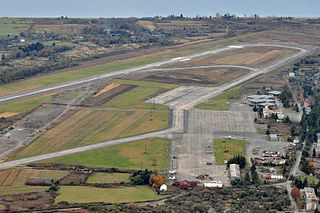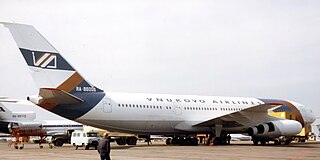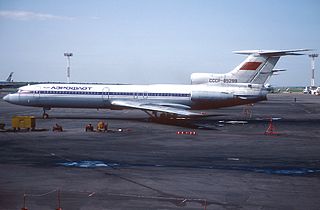
The Tupolev Tu-114 Rossiya is a retired large turboprop-powered long-range airliner designed by the Tupolev design bureau and built in the Soviet Union from May 1955. The aircraft was the largest and fastest passenger plane at that time and also had the longest range, at 10,900 km (6,800 mi). It has held the official title of fastest propeller-driven aircraft since 1960.

The Tupolev Tu-134 is a twin-engined, narrow-body jet airliner built in the Soviet Union for short and medium-haul routes from 1966 to 1989. The original version featured a glazed-nose design and, like certain other Russian airliners, it can operate from unpaved airfields.

The Tupolev Tu-104 is a retired medium-range, narrow-body, twin turbojet-powered Soviet airliner. It was the second to enter regular service, behind the British de Havilland Comet and was the only jetliner operating in the world from 1956 to 1958, when the British jetliner was grounded due to safety concerns.

The Tupolev Tu-154 is a three-engined, medium-range, narrow-body airliner designed in the mid-1960s and manufactured by Tupolev. A workhorse of Soviet and (subsequently) Russian airlines for several decades, it carried half of all passengers flown by Aeroflot and its subsidiaries, remaining the standard domestic-route airliner of Russia and former Soviet states until the mid-2000s. It was exported to 17 non-Russian airlines and used as a head-of-state transport by the air forces of several countries.

From 20 to 23 September 1993, during the Sukhumi massacre, separatists in Sukhumi, Abkhazia blocked Georgian troops' overland supply routes as part of the war in Abkhazia. In response, the Georgian government used Sukhumi Babushara Airport to ferry supplies to troops stationed in Sukhumi. Abkhaz forces attacked the airport in an attempt to further block the supply routes.

The Tupolev Tu-124 is a 56-passenger short-range twinjet airliner built in the Soviet Union. It was the first Soviet airliner powered by turbofan engines.
Kazakhstan Airlines was an airline from Kazakhstan, serving as national flag carrier of the country from its independence in 1991 until 1996. Following the disaster of the Charkhi Dadri mid-air collision, Kazakhstan Airlines ceased operations, and its role as flag carrier was transferred to Air Kazakhstan.
Aviastar-TU Airlines is a Russian cargo charter airline which operates principally out of Ramenskoye Airport in Moscow, Russia. Its headquarters is located in Zhukovsky, Moscow Oblast.

Alykel International Airport is a large international airport in Krasnoyarsk Krai, Russia, located 35 kilometres (22 mi) west of Norilsk. Alykel is the only functional airfield near Norilsk. It handles medium-sized aircraft and is serviced by 24-hour operations. Since it is capable of handling wide-body jets, it is a diversion airport on Polar route 1. Since Norilsk does not have road or railroad connections to the rest of the country, the airport is the main gateway to the city.

Aeroflot Flight 5143 was a domestic scheduled Karshi–Ufa–Leningrad passenger flight that crashed near Uchkuduk, Uzbek SSR, Soviet Union, on 10 July 1985. The crash killed all 200 occupants on board. Investigators determined that crew fatigue was a factor in the accident.

Aeroflot Flight 3352 was a regularly scheduled Aeroflot flight from Krasnodar to Novosibirsk, with an intermediate landing in Omsk. While landing at Omsk Airport on Thursday, 11 October 1984, the aircraft crashed into maintenance vehicles on the runway, killing 174 people on board and four on the ground. While a chain of mistakes in airport operations contributed to the accident, its major cause was an air traffic controller falling asleep on duty. As of 2022, this remains the deadliest aviation accident on Russian territory. It was also the deadliest aviation accident involving a Tupolev Tu-154 at the time until the crash of Aeroflot Flight 5143 nine months later; as of 2023, it still ranks as the second-deadliest accident involving a Tupolev Tu-154. The tragedy was kept secret for twenty years, until Komsomolskaya Pravda published an article in 2004.

Vnukovo Airlines was a Russian airline which had its corporate headquarters at Vnukovo International Airport in Moscow. It was created as a spin-off from the Vnukovo Airport division of Aeroflot in March 1993 and operated until 2001, when it was bought by Siberian Airlines.

Aeroflot Flight 4225 was a Tupolev Tu-154B-2 on a scheduled domestic passenger flight from Alma-Ata Airport to Simferopol Airport on 8 July 1980. The aircraft had reached an altitude of no more than 500 feet when the airspeed suddenly dropped because of thermal currents it encountered during the climb out. This caused the airplane to stall less than 5 kilometres from the airport, crash and catch fire, killing all 156 passengers and 10 crew on board. To date, it remains the deadliest aviation accident in Kazakhstan.

Aeroflot Flight 141 was an international flight from Moscow to Prague. On 19 February 1973, the Tupolev Tu-154 crashed 1.5 kilometres short of runway 25 of Prague Ruzyně Airport. Most of the passengers survived the crash, but many died in the fire that followed. Out of the 87 passengers and 13 crew members, 62 passengers and 4 crew members perished with 18 occupants having serious injuries and the remaining 16 with either minor or no injuries. The crash was the first loss of and first fatal accident involving the Tu-154.

Aeroflot Flight 03 was a passenger flight from Khabarovsk Airport to Petropavlovsk-Kamchatsky Airport. On 3 September 1962 the Aeroflot Tupolev Tu-104 lost control after the airframe started vibrating, resulting in the plane rolling and yawing several times at an altitude of 4,500 meters before crashing. The aircraft crashed into a swamp, some 90 kilometers away from Khabarovsk. At the time, it was the deadliest crash in the history of Soviet aviation.

Aeroflot Flight 3519 was a Tupolev Tu-154B-2 airline flight on a domestic route from Krasnoyarsk to Irkutsk on 23 December 1984. Shortly after takeoff, the No. 3 engine caught fire, and the airplane crashed during an emergency landing. This killed 110 people; there was only one survivor, and the aircraft was destroyed. The engine fire was caused by a manufacturing defect in the compressor disk.

Aeroflot Flight 3739 was a regularly scheduled Russian domestic flight from Irkutsk to Pulkovo Airport in Saint Petersburg that crashed during takeoff from Irkutsk International Airport on 9 February 1976. Twenty-four of the 114 people on board died in the accident.

Aeroflot Flight 2022 was a scheduled Soviet domestic passenger flight between Vilnius Airport in Lithuanian SSR and Vnukovo International Airport in Moscow, Russian SFSR, Soviet Union that crashed on 16 December 1973, killing all 51 people on board. The five hundred mile flight suffered a loss of control as a result of a malfunction of its elevator, causing it to crash as it made its final descent into Moscow. At the time of the crash it was the worst accident in aviation history involving a Tupolev Tu-124, since it entered service with Aeroflot in 1962.

Aeroflot Flight 699 was a scheduled flight, operated by Tupolev Tu-154B CCCP-85254, from Moscow Domodedovo Airport to Krasnovodsk Airport that crashed on approach to its destination.
















